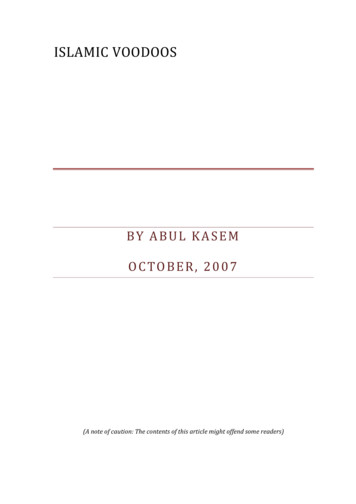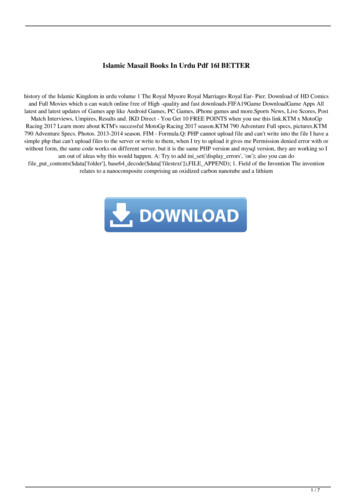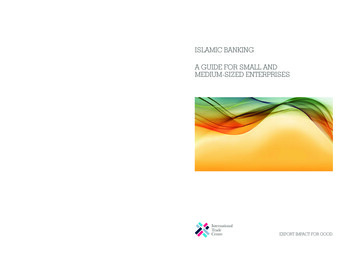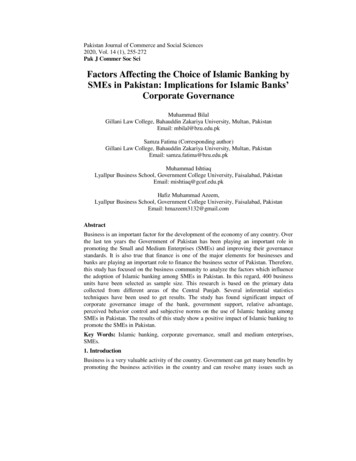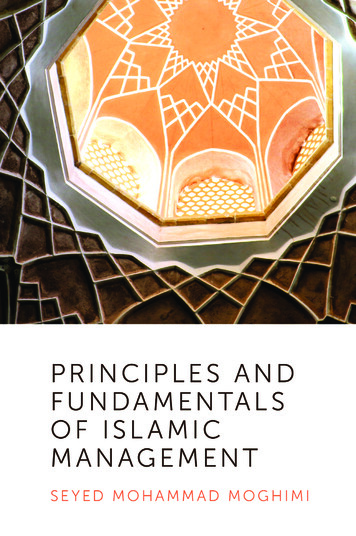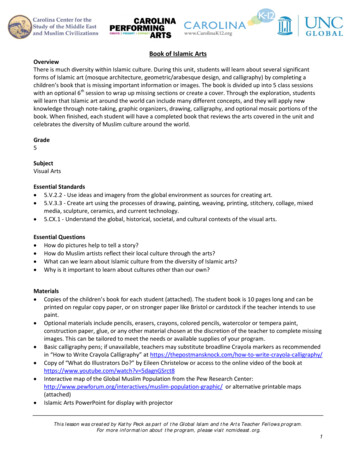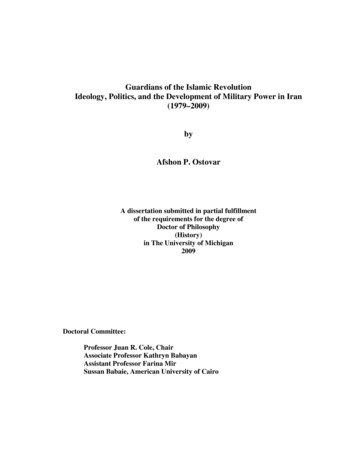
Transcription
Guardians of the Islamic RevolutionIdeology, Politics, and the Development of Military Power in Iran(1979–2009)byAfshon P. OstovarA dissertation submitted in partial fulfillmentof the requirements for the degree ofDoctor of Philosophy(History)in The University of Michigan2009Doctoral Committee:Professor Juan R. Cole, ChairAssociate Professor Kathryn BabayanAssistant Professor Farina MirSussan Babaie, American University of Cairo
Copyright 2009 Afshon P. Ostovarii
AcknowledgementsThis dissertation would not have been possible without the assistance of severalindividuals and the continual support of the University of Michigan’s Rackham GraduateSchool and Department of History. The latter institutions provided me with theorganizational scaffolding and financial resources to pursue and complete my doctoraldegree. The Department of History’s administrative staff—particularly Lorna Altstetter,Kathleen King, Diana Denney, and Sheila Coley—are truly the unsung heroes of everydoctoral student’s career, and especially mine. They made navigating the endlesspaperwork and bureaucratic processes of graduate school nearly painless and far moreefficient than I could have hoped. My research was greatly assisted by the kind efforts ofJonathan Rodgers, Middle East Bibliographer at the University of Michigan’s HatcherGraduate Library, who helped me obtain various Persian sources and microfilms thatproved invaluable to my study. The librarians at the Hoover Institution Library andArchives spent many hours assisting me in navigating their extensive visual and textualcollections. My writing benefitted from the tolerant culture of Ann Arbor’s cafés, whichallow graduate students to loiter at all times of the day and night. I am especially thankfulto the Sweetwaters on Plymouth, where I spent hours of each day writing the last half ofthis dissertation. Even though I had a well-lit, spacious, and surprisingly chilly basementin which to work, the atmosphere at this café allowed me to focus on my writing in waysI could not at home.My pursuit of a doctoral degree in history would not have occurred had I notbenefited from the mentorship of Richard Eaton during my undergraduate years at theUniversity of Arizona. Although my intellectual path has led me away from thepremodern world—at least for now—Professor Eaton’s lessons on Islamic history remainfoundational to my work. Thomas Trautmann was likewise a kind supporter of my workii
and a trusted adviser during my stay at Michigan. My thinking on cultural history andEuropean religious movements was greatly enriched by Helmut Puff. Abbas Milanioffered valuable advice and suggestions at the outset of my study. Farina Mir’sscintillating scholarly mind helped sharpen my project from its earliest incarnation as aprospectus, and the anticipation of her comments kept me from straying too far from thesources. I owe my appreciation and love for the visual to Sussan Babaie and herinspirational approach to scholarship. She has been instrumental in this project’s success,and her friendship has been one of the brightest points of our years in Ann Arbor. I amindebted to Kathryn Babayan for showing me the vast possibilities of textual sources, forteaching me novel approaches to Iranian and Islamic history, and for her continualsupport and friendship. I hold the highest measure of gratitude for Juan Cole, whosementorship, advocacy, pragmatism, and skillful advice have enabled the completion ofthis dissertation and whose enthusiastic support has helped me transition to a professionalcareer.The endless hours of isolation spent producing a doctoral dissertation is enough todrive any graduate student a little insane. I am thus eternally indebted to all my friendsand family whose love, understanding, and unconditional support served as the anchorsthat kept me grounded and free of any actual psychological trauma. My parents inparticular managed to balance their anxiousness for me to finish with the patience thatonly parents can posses. My cat, Saffron, has in her own way kept my ego in check at alltimes. Even as I found her need for affection occasionally aggravating—particularly herincessant desire to sleep atop my books as I read them—she has been a constant reminderof the world outside my studies. The last two years of my graduate career were blessedby the arrival of my beautiful daughter Ladan, whose presence has already enriched mylife beyond calculation. She serves as both my paramount motivation and the mostwelcome distraction. My wife Michele is to whom I owe the deepest and most enduringgratitude. Her boundless love, selflessness, and patience are the sole reason I was able tosurvive this doctoral program and complete this work. If anyone was ever deserving of anhonorary doctorate, it is she. Thank you, Michele.iii
Table of ContentsAcknowledgements. iiList of Figures . viiList of Abbreviations . viiiNote on Transliteration .xCHAPTER I. Introduction: Military Power and the Making of the Islamic Republic.1Conflict, Military Power, and Politics .5Military Power in Post-Revolutionary Iran .10CHAPTER II. From Ali to Khomeini: A Brief History of Shiism and the IslamicMovement in Iran (632–1978 C.E.).17PART ONE: SHIISM THROUGH THE 19th CENTURY .19The Formation of Shiite Islam .19Later Developments in Shiism and the Rise of the Clergy.25PART TWO: THE ISLAMIC MOVEMENT IN IRAN.30Roots of the Islamic Movement in the Twentieth Century.30The Islamic Movement and Revolutionary Ideology .37Conclusion .43CHAPTER III. Guardians of an Islamic Revolution: Coercion and Consolidationin the Post-Revolution (February–December 1979) .46Revolution and a New Regime .49Early Leadership and Factions.58Countering the (New) Opposition.66The Clergy and a New Constitution.72iv
Conclusion. 76CHAPTER IV. Exporting the Revolution: The Rise and Decline of theKhomeinist Left (1980–1989).78Roots and Early Expressions of Revolutionary Internationalism .80The Iraq Conflict and an Emergent Conservatism.84Battling Baathists All the Way to Jerusalem .87Exporting the Revolution: the Case of Lebanon .89Waning Interventionism, Rising Conservatism .97Conclusion .101CHAPTER V. Image and Identity: Visualizing the Revolutionary Guards(1979–88).104PART ONE: CONTEXTS .107An Overview of IRGC Publications .107Cultural Activism in a Time of War .110PART TWO: TEXTS.112Branding a New Resistance .112A Militant Iconology.114Imagining Karbala and its Warriors.117Conclusion .126CHAPTER VI. Politics of Demobilization: Veterans and Militarism in the PostwarDecade (1989–1999).129Extra-Military Deployments: Postwar Reconstruction under Rafsanjani .132Commanding “Right”: Legal and Religious Justifications forCoercive Activism .139Militarism and Politics: Coercive Activism against Islamic Modernismand Reform.146Conclusion .155v
CHAPTER VII. Gifts for the Enemy: The War on Terror and its Beneficiariesin Iran (2001–2009) .158War, Fear, and a Nuclear Iran.161Electing Ahmadinejad.167Iran’s Rise as a Regional Power .173New Approaches to a New Threat .180Conclusion .187CHAPTER VIII. Conclusion .190Select Bibliography.205vi
List of FiguresFigure 3.1. MKO and MIR emblems. .65Figure 4.1. Lebanese Hizbullah and IRGC emblems.95Figure 5.1. IRGC emblem.114Figure 5.2. Guard icons from 1981 and 1985 .116Figure 5.3. “Path of Jerusalem . . .” .119Figure 5.4. “Road to Karbala” .120Figure 5.5. “Karbala is waiting . . .” .123Figure 5.6. Warrior of Karbala.125vii
List of AbbreviationsAE(Assembly of Experts)Ansar(Ansar-e Hezbollah)Ayat.(Ayatollah)Basij(Basij popular militia, Basij Resistance Force)Badr(Badr Organization)BBCMME(BBC Monitoring Middle East)BBCSWB(BBC Summary of World Broadcasts)BBCWM(BBC World Monitoring)Dawa(Islamic Dawa Party)GC(Guardian Council)Hamas(Islamic Resistance Movement)Fada’iyan(Fada’iyan-e Islam)Fadai(People’s Fadai, Fada’i-ye Khalq)FBIS(Foreign Broadcast Information Service)IAEA(International Atomic Energy Agency)ILNA(Iranian Labour News Agency)IPRP(Islamic People’s Republican Party)IRGC(Islamic Revolutionary Guards Corps)IRP(Islamic Republic Party)IRNA(Islamic Republic News Agency)ISNA(Iranian Students News Agency)Jondollah(People’s Resistance Movement of Iran)Khatam(IRGC engineering firm, Qaragah-ye sazandegi-ye khatam al-anbia)LEF(Law Enforcement Forces)MDAFL(Ministry of Defense and Armed Force Logistics)MIR(Mojahedin of the Islamic Revolution Organization)viii
MKO(Mojahedin-e Khalq Organization)NPT(Non-Proliferation Treaty)NIE(National Intelligence Estimate)OLM(Office of Liberation Movements)OSC(Open Source Center)Payam(Payam-e Enqelab)PLO(Palestinian Liberation Organization)PVPV(Propagation of Virtue and Prohibition of Vice)SAVAK(National Intelligence and Security Organization of the Pahlavi regime)SCIRI(Supreme Council of Islamic Revolution in Iraq)SICI(Supreme Islamic Council of Iraq, formerly SCIRI)WMD(Weapons of mass destruction)ix
Note on TransliterationFor the transliteration of Persian and Arabic words I use a modified version of thetransliteration system used by the International Journal of Middle East Studies. In anattempt to simplify spellings I omit all diacritical marks, including those used to indicatethe letter ‘ayn and the hamzeh, in transliterating most proper nouns. I do, however,include ‘ayn (‘) and hamzeh (’) diacritics in those Persian and Arabic terms placed withinparenthetical marks. To more closely render Persian words as they are pronounced inPersian, short vowels follow Persian rather than Arabic pronunciation (i.e. “e” and “o”are used in place of “i” and “u”). Words and proper nouns that are commonly found inEnglish, such as jihad, Imam, Shiite, or Khomeini, will follow their alreadycommonplace spellings. The one exception is the word Hezbollah, which is both thename of a Lebanese militant organization and a term used to describe various groups inIran, such as the Ansar-e Hezbollah organization. To distinguish between these usages,transliteration for the Lebanese organization follows Arabic pronunciation (Hizbullah)and the Persian term follows Persian pronunciation (Hezbollah).x
CHAPTER IIntroduction:Military Power and the Making of the Islamic RepublicThis study examines the construction of a new political order in post-revolutionary Iranthrough the prism of its revolutionary armed forces. I specifically explore the place of theIslamic Revolutionary Guards Corps (IRGC) in this process, and focus on its role inestablishing and maintaining state control. Like all governments, the Islamic Republic’sfirst obligation has been to ensure its survival. 1 In doing so it has relied on variousmechanisms of coercion and control. Military power has been central to this effort. Themilitary in post-revolutionary Iran is composed of two main segments: regular forces andrevolutionary forces. The former—which comprise an army, navy, and air force—areholdovers from the pre-revolutionary period and have mattered little to the politicaldevelopment of the Islamic Republic. The revolutionary forces, however, which includethe IRGC, the Basij popular militia, and other associated forces, have had a significantimpact on the shape and nature of the Iranian state. Unlike the regular armed forces, theIRGC was given the additional mandate of “safeguarding the revolution.” Exercising thisbroad responsibility has led to the gradual permeation of the organization’s influence inall sectors of the Iranian state, including the areas of domestic security, ideologicalpromotion, cultural work, industrial development, foreign engagements, and politics.Despite the IRGC’s prominence in contemporary Iran, only a small handful ofstudies have engaged the subject directly. 2 The bulk of these are studies on Iran’s military1Barnett Rubin, Armed Forces in the Middle East Politics and Strategy. London: Routledge, 2002, p. 2.While only a few works focus on the IRGC exclusively, most studies on post-revolutionary Iran providesome discussion of the organization and its participation in Iranian society. However, it should be notedthat a few studies on post-revolutionary Iran have included substantial discussion and valuable insights on21
capacities written from a strategic studies perspective. 3 Although most of these studiesprovide useful analyses of the structure and capacities of Iran’s armed forces, they aregenerally limited by their narrow focus, their intended audience (mostly American policymakers and defense analysts), and their concentration on secondary English-languagesources. As such they tend to embody several assumptions regarding the underlyingcultural, religious, ideological, and social factors that have shaped Iranian society and itsmilitary organizations. Most problematic, at least in my estimation, is the use of termslike “fanatical,” “fundamentalist,” and “Islamic” to describe Iran’s leaders and militarycommanders. This is not to say that those terms cannot or do not have a place in such adiscussion, rather it is to suggest that those terms left unpacked and poorly defined dolittle else but obfuscate the complex and nuanced reality of power and authority in Iran.They further perpetuate the belief held by many policy makers and analysts that Iran’sleaders and policies are driven in toto by an implacable irrationality that can neither beunderstood nor engaged toward any meaningful end.There are a few exceptions worth mentioning. Sepehr Zabih’s The IranianMilitary in Revolution and War, for instance, offers a brief but valuable early history ofthe IRGC. 4 Published in 1988, Zabih marshals a variety of Persian sources and includessections on the IRGC and Basij as part of a larger study on Iran’s armed forces. The onlyreal limitation of Zabih’s study is its temporal and thematic scope. Regarding the latter,Zabih’s chief interest in the IRGC is its place in Iran’s greater military sector and he onlybriefly considers the organization’s ideological, religious, and political roles. In additionto Zabih’s work are two studies by the Rand Corporation. The first, a study on Iran’smilitary published in 1987, is similar to Zabih’s work in both subject matter and in theperiod covered. While the authors’ treatment of ideological and religious factors isthe IRGC. See particularly, Ali Ansari, Iran, Islam and Democracy: the Politics of Managing Change.London: Chatham House, 2006; Anoushirvan Ehteshami and Mahjoob Zweiri, Iran and the Rise of itsNeoconservatives: The Politics of Tehran’s Silent Revolution. London and New York: I.B. Tauris, 2007;Mehdi Moslem, Factional Politics in Post-Khomeini Iran. Syracuse: Syracuse University Press, 2002.3See in particular, Anthony H. Cordesman, Iran’s Military in Transition: Conventional Threats andWeapons of Mass Destruction. West Port: Praeger, 1999; Anthony H. Cordesman and Ahmed S. Hashim,Iran: Dilemmas of Dual Containment. Boulder: Westview Press, 1997; Michael Eisenstadt, IranianMilitary Power: Capabilities and Intentions. Washington D.C.: Washington Institute of Near East Policy,1996; Steven M. Ward, Immortal: A Military History of Iran and Its Armed Forces. Washington D.C.:Georgetown University Press, 2009; Frederic Wehrey et al., Dangerous But Not Omnipotent: Exploring theReach and Limitations of Iranian Power in the Middle East. RAND, 2009.4Sepehr Zabih, The Iranian Military in Revolution and War. London and New York: Routledge, 1988.2
likewise limited, they provide an informative analysis of the early structure of the IRGC. 5Unlike the aforementioned, the second Rand study is both recent and exclusively focusedon the IRGC. 6 This study, published in 2009, offers a broad overview of the IRGC’scurrent domestic activities and the organization’s impact on Iranian politics. Its greateststrength is a survey of the IRGC’s economic and financial interests, which although brief,provides the best introduction to the subject yet published in English. To this extent, thisstudy is a valuable primer for policy makers and analysts for whom it was produced.However, the authors also perpetuate assumptions of IRGC fanaticism and as such dolittle to depart from the standard narratives of the organization and of the IslamicRepublic in general. Further, as the authors’ focus is on the contemporary, they only offera brief and incomplete analysis of IRGC history.Beyond these works, the only serious academic study dedicated solely to theIRGC is Kenneth Katzman’s Warriors of Islam: Iran’s Revolutionary Guard. Publishedin 1993, this book considers the IRGC an ideological military organization with astringent political agenda. 7 Katzman, a political scientist, uses Samuel Huntington’stheory of institutionalization to examine the internal make-up and development of theRevolutionary Guards. He concludes that although the IRGC has taken on the airs andsome of the institutional characteristics of a professional military organization, itsdedication to radical ideology and involvement in politics has prevented it frombecoming a professional armed force. While his treatment of the IRGC and its internaldevelopment is valuable, Katzman’s work suffers from a few major limitations. First andmost importantly, Katzman relies on only English language sources for his research.Some of these are legitimate and helpful translations and overviews of Persian articles,such as those provided by FBIS and the Iran Weekly Press Digest. However, because ofthis limitation, Katzman was unable to analyze or even consider the vast amount ofmaterials published by the Guards and other Persian sources concerning or associatedwith the organization. Secondly, I would suggest and others have argued that the5Nikola B. Schahgaldian and Gina Barkhordarian, The Iranian Military under the Islamic Republic. SantaMonica, CA: RAND, 1987.6Frederic Wehrey et al., The Rise of the Pasdaran: Accessing the Domestic Roles of Iran’s IslamicRevolutionary Guards Corps. RAND National Defense Research Institute, 20097Kenneth Katzman, The Warriors of Islam: Iran’s Revolutionary Guard. Boulder: Westview Press, 1993.Also see, Katzman’s "The Pasdaran: Institutionalization of Revolutionary Armed Force." Iranian Studiesvol. 26, no. 3-4 (1993), pp. 389-402.3
explanatory capacity of Katzman’s study is considerably restricted due to his use ofHuntington’s institutionalization theory, which as a model developed to understandwestern-oriented political institutions, seems ill-fitted to explain the development of anunconventional, clerically-sponsored, and religiously-minded armed force in postrevolutionary Iran. 8 Third, while Katzman bases much of his argument on the Guardsreligious “radicalism” he never unpacks this term nor examines their actual writings onthe subject. Finally, while Katzman provides useful information on IRGC history, thestructure of his study scatters this information piecemeal throughout the book, whichmakes for a laborious and frustrating read. While these factors limit the success ofKatzman’s investigation, they do not tarnish the strengths of his work. Indeed, his bookprovides astute observations on the IRGC’s structure and development, and offers avaluable analysis of IRGC factionalism.There are three major limitations in this body of literature: First, with theexception of Rand’s 2009 study, the majority of work produced on the IRGC is outdated,and no study to date has offered a current or coherent history of the organization. Second,while some of these studies (Zabih and both Rand publications) consider Persianmaterials, they largely do not explore the numerous publications of the organization orthe many memoirs written by founding IRGC members and early leaders of the IslamicRepublic. Third, while the IRGC’s ideological nature is consistently emphasized, thedevelopment of the organization’s ideological commitments, their cultural and religiousdimensions, and the relationship between these factors and the organization’s place andwork within Iranian society have not been adequately explored. The present study isintended to begin addressing these shortcomings. To this end, my analysis considers thevarious dynamics and pressures which have shaped the IRGC over the last three decadesand which have influenced its impact on the post-revolutionary Iranian state. In thefollowing pages I briefly discuss the larger questions and issues at work in this study andthe framework that will structure my discussion. Next I will introduce the central and subtheses of this work and what these arguments can tell us about the subject. Finally, Iprovide a brief summary of the subsequent chapters and list some larger questions towhich I will return in the study’s conclusion.8See James A. Bill’s commentary in Iranian Studies vol. 26, no. 3-4 (1993), p. 403.4
Conflict, Military Power, and PoliticsThe relationship between conflict and national politics is an underlying subject of thisstudy. Over the last few decades countless studies in history, sociology, and politicalscience have examined the war-making/state-making nexus. Macro-comparativeinvestigations by scholars like Charles Tilly and Michael Mann (both rooted in the ideasof Max Weber) have produced useful theoretical models that place war and militaries atthe center of state formation. 9 Taken together, the overall model of war-making and stateformation includes four major claims. First, the process of waging war created theinstitutional apparatus of the modern state, which relied on both technologies ofextraction and coercion to mobilize the resources and man-power to make fighting warpossible. Second, to facilitate the mobilization of resources and military personnel stateleaders offered incentives such as the rule of law and representative government to theircivilian populations. Third, through disarming its population and achieving the capacityto wage and fight war the state developed a near monopoly of legitimate coerciveviolence. Fourth, the development of civilian institutions eventually curbed the autonomyof military power and brought it under civilian control. This led to a division of coerciveforces into those specializing in external conflicts (the military) and those concerned withinternal threats (the police).This model is helpful for understanding the place of military power in the stateformation of modern Europe; however its European bias limits the utility of itsapplication elsewhere. That is, the European model of state formation through warfare is,as has been noted by some scholars, more exception than rule. For instance, in a study onthe significance of war to the creation of states and national armed forces in LatinAmerica, political scientist Miguel Centeno questions the viability of Tilly’s model of9See Charles Tilly’s Coercion, Capital, and European States, AD 990-1990. Cambridge: Basil Blackwell,1990; “Armed Force, Regimes, and Contention in Europe since 1650,” in Irregular Armed Forces and theirRole in Politics and State Formation. Diane E. Davis and Anthony W. Pereira eds. Cambridge: CambridgeUniversity Press, 2003, pp. 37-81; and “War Making and State Making as Organized Crime,” in Bringingthe State Back In. Peter B. Evans et al. eds. Cambridge: Cambridge University Press, 1985, pp. 169-191.Also see Michael Mann’s The Sources of Social Power, Volume I: A History of Power from the Beginningto A.D. 1760. Cambridge: Cambridge University Press, 1986; and The Sources of Social Power, Volume II:The Rise of Classes and Nation States, 1760-1914. Cambridge: Cambridge University Press, 1993.5
state formation and military development for non-European states. 10 Here Centeno positsthat unlike the inter-state warfare—particularly the “total wars” of the first and secondworld wars—that helped define the national boundaries of modern Europe, LatinAmerican states have been involved in only “limited wars” against mostly internal ormarginal threats. Unlike the “total wars” fought by European states, fighting “limitedwars” did not require the mobilization of large standing armies, the technologicalcapacity to supply forces across large and disparate expanses, the requirement of a singleand coherent national ideology, nor the development of professionalized andconventional militaries. Centeno’s work further suggests that the fighting of “limitedwars”—as opposed to total wars—limited a state’s ability to concentrate the means ofviolence within society while European states were more successful in this regard.Though Centeno does see some parallels between the European and Latin Americanexperiences in the twentieth century, specifically the direct link between armed conflictand state formation, he concludes that the above differences are significant and show thelimited utility of Tilly’s model (and by extension other European-centric theories) for thestudy of non-European states.Centeno’s study brings to the fore another weakness in the literature on armedforces and politics: the focus on conventional militaries. Conventional militaries aregenerally conceived as centralized national institutions that are subordinate to the state.These militaries include hierarchical command structures, rigid institutional cultures, andan officer corps comprised of the social elite. Further, and perhaps most significantly,these armed forces are designed to concentrate on external threats, particularly thoseposed by neighboring states, and have only a limited sub-national role. The focus onconventional forces thus includes a number of assumptions regarding the place ofmilitary power in national politics. Studies on conventional militaries and their role inpolitical d
only parents can posses. My cat, Saffron, has in her own way kept my ego in check at all times. Even as I found her need for affection occasionally aggravating—particularly her incessant desire to sleep atop my books as I read them—she has been a constant reminder of the world outside my studies.


